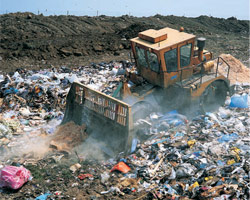Methane Capture and Use

You've probably heard about the three R's. While it's important to reduce, reuse, and recycle as much as you can, it's hard to avoid throwing out some trash every week. Trash that cannot be recycled or reused often ends up in landfills, where it produces methane as it decomposes.
Methane is a very powerful greenhouse gas. One pound of methane traps 25 times more heat in the atmosphere than a pound of carbon dioxide. Methane is also the main ingredient in natural gas. Because methane can be captured from landfills, it can be burned to produce electricity, heat buildings, or power garbage trucks. Capturing methane before it gets into the atmosphere also helps reduce the effects of climate change.
Methane can also be captured from farm digesters, which are big tanks that contain manure and other waste from barns that house livestock such as cows and pigs.
How It Works

- Trash decomposes (or rots) in landfills, creating methane gas.
- Methane rises to the top of the landfill and is collected in pipes.
- The methane is burned to produce heat or generate electricity.
Cool Facts
- Putting waste to good use. More than 500 landfill–to–energy projects are currently operating in the United States, and another 500 landfills are good candidates for turning their methane into an energy resource, which would produce enough electricity to power nearly 688,000 homes across the nation.
- Top producer. In 2009, Germany produced enough electricity from biogas to power 3.5 million homes.
- A world first! Sweden has been operating a biogas-powered train since 2005. It shuttles passengers between two cities that are 75 miles apart.